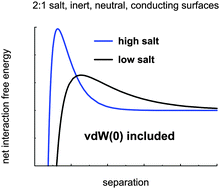On the stability of aqueous dispersions containing conducting colloidal particles†
Abstract
We use a combination of simulations and a simple theoretical approach to investigate interactions between neutral conducting surfaces, immersed in an electrolyte solution. The study is conducted at the primitive model level, which necessitates the use of multiple image reflections. Our approximate theory is based on a classical density functional formulation of Poisson–Boltzmann theory. The same approach can in principle also be imported to more advanced treatments, where ion correlations are accounted for. An important limiting result that guides our treatment of the image forces, is that the repulsive salt-induced interactions cancel the attractive zero frequency van der Waals attraction at long range. That is, at vanishing frequency, the van der Waals interaction between the conducting surfaces is, at large separations, perfectly screened by the intervening salt solution. The simulations are computationally intensive, due to a strong dependence upon the number of image reflections used, with especially poor convergence when an odd number of images is used. We demonstrate that our approximate density functional approach is remarkably accurate, even in the presence of a 2 : 1 salt, or when the surfaces preferentially adsorb one ion species. The former observation was rather unexpected, given the lack of ion correlations within our mean-field treatment, and is most likely due to a cancellation between two opposing effects, both of which are generated by ion correlations.


 Please wait while we load your content...
Please wait while we load your content...